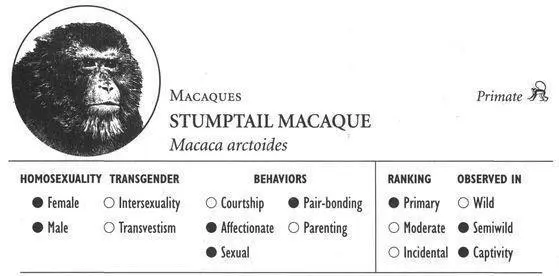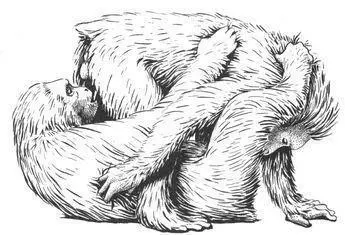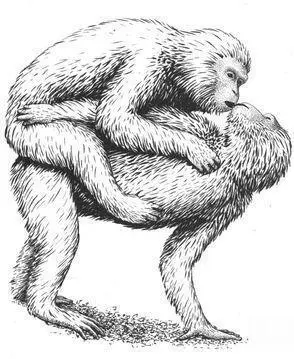———(1970) “Peri-Menstrual Sexual Behavior Among Rhesus Monkeys.” Folia Primatologica 13:286-97.
Michael, R. P., M. I. Wilson, and D. Zumpe (1974) “The Bisexual Behavior of Female Rhesus Monkeys.” In R. C. Friedman, ed., Sex Differences in Behavior , pp. 399–412. New York: John Wiley & Sons.
Missakian, E. A. (1973) “Genealogical Mating Activity in Free-Ranging Groups of Rhesus Monkeys ( Macaca mulatta ) on Cayo Santiago.” Behavior 45:225–41.
Partch, J. (1978) “The Socializing Role of Postreproductive Rhesus Macaque Females.” American Journal of Physical Anthropology 48:425.
*Reinhardt, V., A. Reinhardt, F. B. Bercovitch, and R. W. Goy (1986) “Does Intermale Mounting Function as a Dominance Demonstration in Rhesus Monkeys?” Folia Primatologica 47:55–60.
Rowell, T. E., R. A. Hinde, and Y. Spencer-Booth (1964) “‘Aunt’-Infant Interaction in Captive Rhesus Monkeys.” Animal Behavior 12:219–26.
*Sade, D. S. (1968) “Inhibition of Son-Mother Mating Among Free-Ranging Rhesus Monkeys.” In J. H. Masserman, ed., Animal and Human, pp. 18–38. Science and Psychoanalysis, vol. 12. New York: Grune & Stratton.
Schapiro, S. J., and G. Mitchell (1983) “Infant-Directed Abuse in a Seminatural Environment: Precipitating Factors.” In M. Reite and N. G. Caine, eds., Child Abuse: The Nonhuman Primate Data , pp. 29–48. Monographs in Primatology, vol.1. New York: Alan R. Liss.
*Sullivan, D. J., and H. P. Drobeck (1966) “True Hermaphrodism in a Rhesus Monkey.” Folia Primatologica 4:309–17.
Tilford, B. (1981) “Nondesertion of a Postreproductive Rhesus Female by Adult Male Kin.” Journal of Mammalogy 62:638–39.
Vessey, S. H., and D. B. Meikle (1984) “Free-Living Rhesus Monkeys: Adult Male Interactions with Infants and Juveniles.” In D. M. Taub, ed., Primate Paternalism , pp. 113–26. New York: Van Nostrand Reinhold.
*Weiss, G., R. F. Weick, E. Knobil, S. R. Wolman, and F. Gorstein (1973) “An X-O Anomaly and Ovarian Dysgenesis in a Rhesus Monkey.” Folia Primatologica 19:24–7.

IDENTIFICATION: A medium-sized (2-foot-long) monkey with dark or reddish brown fur, a short, almost hairless tail, and mottled black-and-red skin on the face. DISTRIBUTION: Southeast Asia and south-central China; vulnerable. HABITAT: Dense forests, including mountainous regions. STUDY AREAS: Semiwild: island of Toto-gochillo, Lake Catemaco, Mexico; captivity: Stanford University; University of Helsinki; the Netherlands Primate Center; Yerkes and Wisconsin Regional Primate Research Centers; Calcutta and Paris Zoos.
Social Organization
Few field studies of Stumptail Macaques have been conducted, so little is known of their social organization in the wild. They generally appear to live in cosexual groups of 20–50 individuals with a matrilineal organization. The mating system is probably polygamous or promiscuous, involving copulations with multiple partners and little male parental involvement.
Description
Behavioral Expression: Male Stumptails form intense sexual “friendships” with each other, within which an extraordinary variety of homosexual activities are expressed. One male may develop strong affectionate bonds with another male, as shown by their embracing, gently nibbling at each other’s mouth, and huddling together. The two partners may even sleep together, one closely hugging the other from behind while holding his partner’s penis. The affection between these males is also expressed through sexual activity, ranging from mounting to oral sex to mutual masturbation. Mounting occurs in the typical front-to-back position found in heterosexual mating; pelvic thrusting, anal penetration, and occasionally ejaculation can all be components of this activity. Fellatio or oral-genital activity involves one male licking or sucking on the penis of the other for up to two minutes at a time. This is done in a variety of positions, for example with one male behind the other or mounted on him, sucking his genitals between his legs. The males may even perform mutual fellatio in a 69 position. Males also fondle one another’s scrotum and penis, rubbing the hand up and down the shaft; again, a number of positions are used—one male may stand sideways in front of another who is sitting down, spreading his thighs to allow the seated male to masturbate him, or they may engage in mutual masturbation by backing up toward each other and fondling each other’s genitals between their legs. Sometimes male Stumptails also sit together and masturbate themselves, stimulated by the sight of one another or of a nearby heterosexual mating. The partners in a sexual friendship may be of the same age, or one may be considerably younger than the other, perhaps even an infant.
Two male Stumptail Macaques in mutual fellatio

Female Stumptails also form sexual friendships with one another. These relationships, which involve a considerable amount of affectionate behavior as well, may be a stable association between just two females, or they may be more fluid, involving a network of three females, for example, or more short-lived pairings. Sexual behavior involves mounting with intense genital stimulation and orgasm. One female will climb onto the back of her favorite partner, using a position slightly different from heterosexual mating that allows her to rub her genitals against the rump of the other female. This may also be accomplished in a front-to-back sitting position, one female pulling the other up against her belly, and the two may even end up lying or leaning back together in this configuration. Lesbian interactions are prolonged, lasting up to two minutes (a duration similar to heterosexual mating), and the females usually make numerous pelvic thrusts comparable to the amount performed by a male in a heterosexual mounting. Orgasm is striking: the mounting female tenses up, first pausing and then showing a number of body spasms; her fur stands on end, and this is combined with a characteristic frowning and round-mouthed facial expression (also found in ejaculating males) and rapid breathing sounds. She also experiences a number of intense uterine contractions lasting for nearly a minute. The female being mounted does not, apparently, have the same sort of orgasmic response, although she is in a state of high sexual arousal, and will often reach back to clutch the mounting female and even kiss her during the climax. Following orgasm, the females usually hug one another and make teeth-chattering or squeaking sounds. In some cases females can apparently reach orgasm without direct genital stimulation, particularly when they are hugging their favorite female partner in great excitement after being reunited.
A female Stumptail Macaque kissing her female partner at the climax of mounting

Frequency: Homosexual activity is common in Stumptail Macaques, accounting for as much as 25–40 percent of all sexual encounters in some captive and semi-wild groups. In one study, nearly two-thirds of this same-sex activity was between females, while in another population, all same-sex mounting was between males.
Orientation: Most Stumptail females are probably simultaneously bisexual, interspersing heterosexual activity with homosexual activity. In fact, females have been known to participate in lesbian activities when they are lactating (and possibly even during pregnancy), indicating an easy compatibility between motherhood and homosexuality in this species. Some males show a decrease in the intensity of their same-sex friendships as they get older and may begin engaging in a larger proportion of heterosexual activity as they mature. Nevertheless, most males probably continue to have some homosexual contact throughout their lives.
Читать дальше















